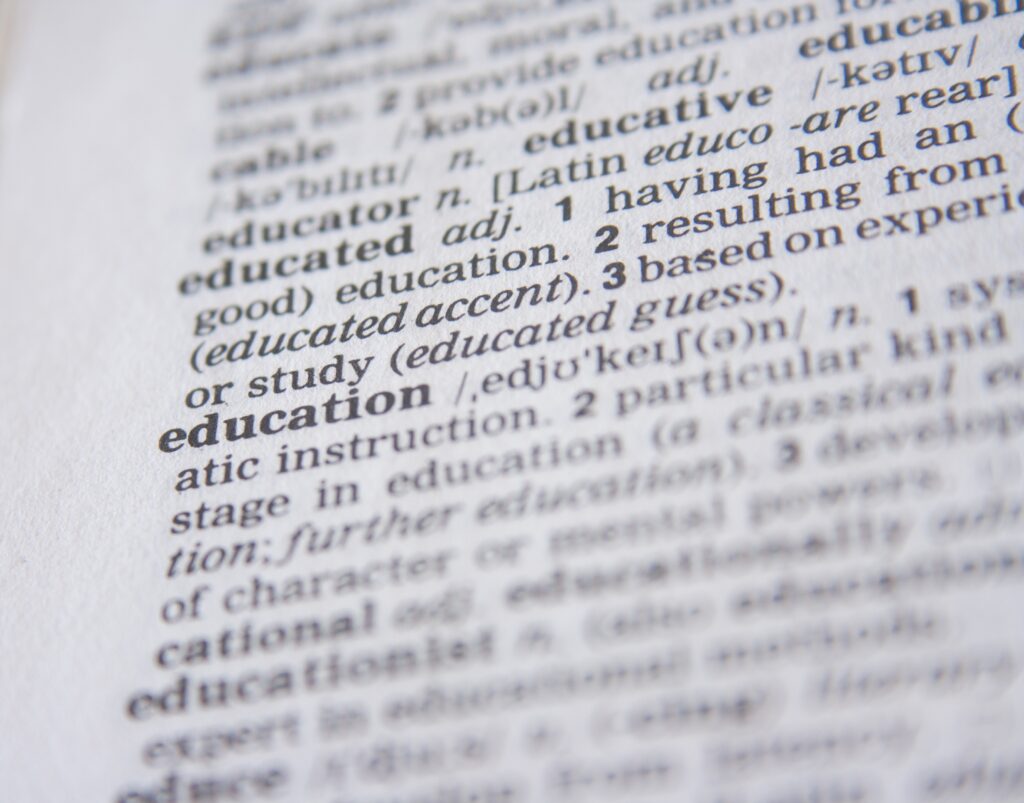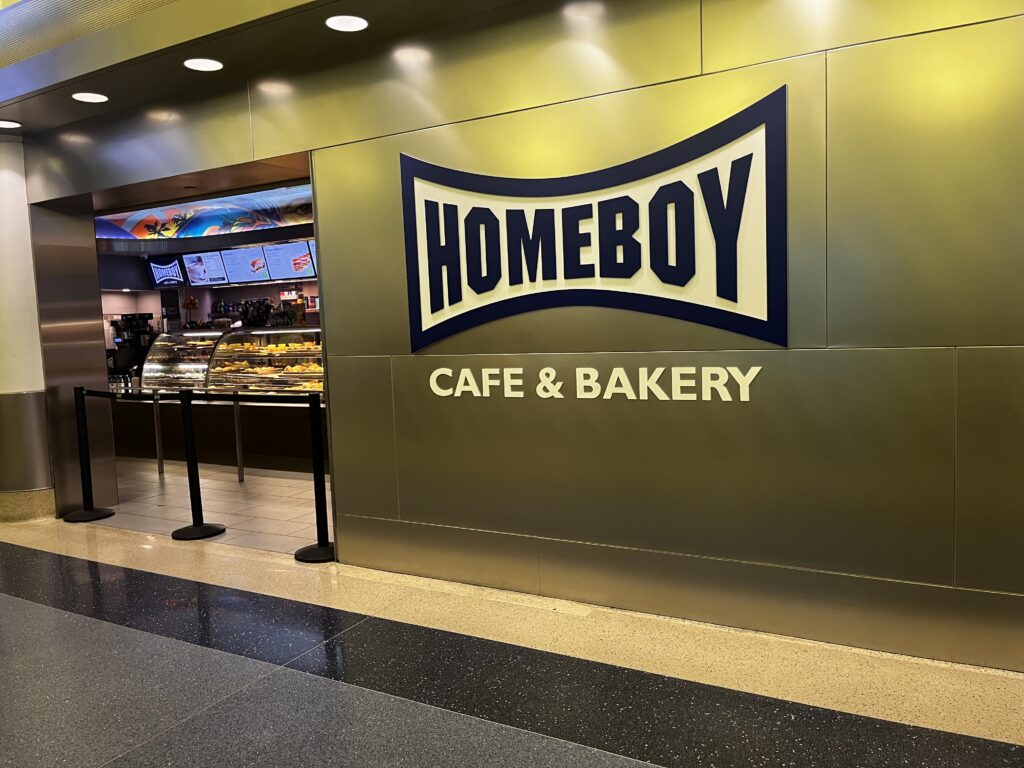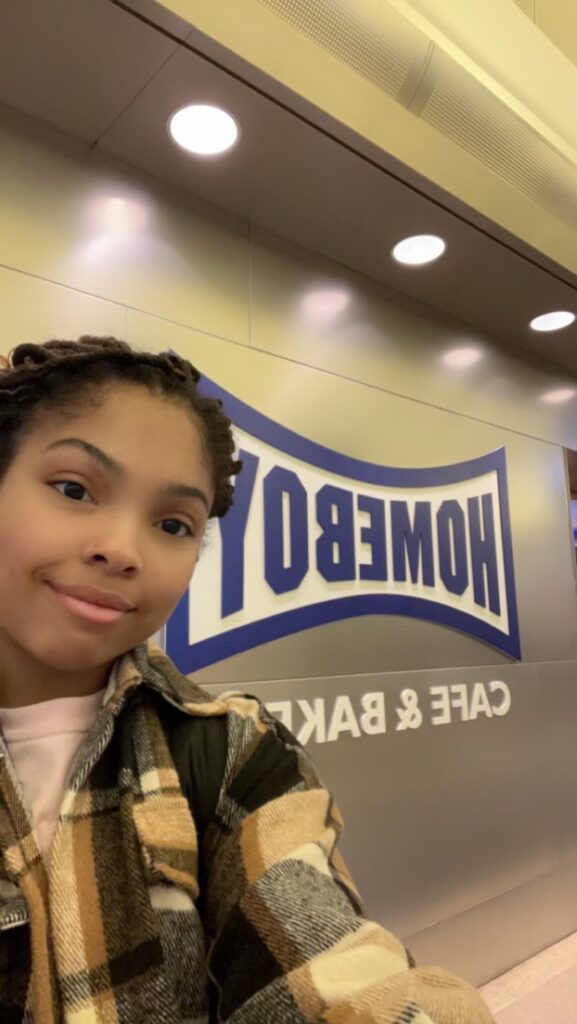Written by: Ella Jackson
July 5, 2024
2018 was an educational summer.
I had a full-ride scholarship for a criminal justice program at the University of Southern California (USC), where I had the special opportunity to live the life of a Trojan and earn college credit for one month.
Every day, I walked in the scorching sun to my classes across campus, where I was studying judicial cases, current laws, and prison systems in California. With special speakers and trips scattered throughout the program, I was given a view of the good, the bad, and the ugly of the Californian justice and prison systems.
One trip in particular stays with me six years later. I still remember what it was like to cross an intersection towards a two-story building with large glass windows, to see that big sign at the top: Homeboy Industries.

Homeboy Industries was established in 1992 to assist the community by offering a variety of free programs to help people recently and previously incarcerated, as well as high-risk youth. Still in operation, Homeboy remains one of the largest rehabilitation and re-entry programs in the world, helping thousands redirect and rebuild their lives. In 2007, they established a new headquarters, a rehab center that has served as a beacon of hope for former gang members. It was that rehab center that I visited in the summer of 2018.
We were given a tour of the center, running into staff who were hired after going through the program or who decided to volunteer their free time in some capacity. We got the opportunity to talk to multiple members of the program who were there to tell their stories and explain how the services helped them make changes in their lives.
As we walked down the halls, we saw that the walls were decorated with inspirational quotes from the founder Father Greg Boyle, and with photos from Homeboy’s programs. At the very end of the hall we had the opportunity to meet some of the educators and tattoo removal artists who volunteered their time at the center.
For our final stop we ate at the Homegirl Cafe, one of the many businesses established by Homeboy Industries to help former gang members and people previously incarcerated to work in a safe and supportive environment and acquire job skills and experience. The cafe was busy and thriving, and we saw many women chefs and waitstaff working, some who we saw earlier in one of the educational classes that we got to step into. The work we saw being done was inspiring—but our class visit also showed us directly how the justice system often lacks the rehabilitation services that it was originally reformed to provide.
Homeboy brought my attention to what the world could be like for those after prison—or what it could be like without prisons at all. Many in prisons face inhumane treatment and bottom-of-the-barrel resources. The system often doesn’t take into account their mental health and any traumatic experiences that may have led to the choices they made.
The result is dehumanization and a lack of rehabilitation for many people who have been previously incarcerated, with the system not focusing on providing the needed tools for re-entry.
Yet, despite it all, communities like Homeboy come together to succeed where the system fails.
So, what are the transformative rehabilitation stories of people who have been previously incarcerated?
In this rabbit hole I will be looking at the work we do in America to provide rehabilitation services before and during re-entry, exploring how programs like Homeboy can improve the lives of those who have been released from prison and help them regain their humanity.
Are you ready? Follow me down.
Down the Rabbit Hole

Background
Is America failing those who have been incarcerated?

Rehabilitation

Re-entry

Rehumanization
Coming Back to a Close
I woke up to a banging at the door…
My month-long pre-college experience at USC had come to an end. After two missed alarms, I woke up to a greeting from my RA with only 15 minutes left to pack. After tossing all my necessities into my one bag, I threw on my leggings and Homeboy Industries sweatshirt, then sprinted to the shuttle downstairs.
I was finally heading back to Virginia from the Los Angeles (LAX) airport. I had traveled alone my entire life, but this was my first time arriving and going through the steps to the plane on my own.
Frozen with fear in the bustling, early-morning airport rush, I checked my bag, made it through TSA, and had an hour to burn by finding my gate and wandering the airport.
Then, my smile grew as I saw a bright, familiar sign.

“Homeboy Cafe and Bakery” was glowing by a long line of starving travelers in Terminal 4. LAX was the first airport to host such a local rehabilitation and re-entry organization. Usually when traveling you expect to see main food chains, so to this day I remember the joy I felt seeing Homeboy’s sign shining so brightly in such a public space for everyone to see.
The cafe served Peet’s Coffee & Tea, along with an assortment of sandwiches and bakery items, perfect for an early morning flight. Though the prices matchesd the high expenses that came with California and eating in an airport, the food looked delicious.
Even looking the business up today, you can tell by the reviews that they are just as busy as ever and bringing awareness to the Homeboy Industries cause.

This was the best possible ending to a trip that I will never forget.
The lasting friendships made, places visited, knowledge gained, and empathy built—I became a better person for it.
Though my studies in California resulted in the changing of my major from Criminal Justice to Global Affairs and Conflict Analysis and Resolution, I know that everything I learned from our classes, the destinations we visited, and people we spoke with will influence me in my future career, regardless of the titles of my degrees. And the work being done at organizations like Homeboy Industries will never be far from my mind.
I hope one day to use the knowledge and experience I gained during that trip and my subsequent studies to help those battling the system in any way possible. To address the need for rehabilitation and re-entry programs and to stop the cycle guiding many into, or back into, prison.
The current system definitely needs an overhaul, but until that day can come, it is important that our society focuses on changing ourselves to be more empathetic. As a society, we need to accept returning citizens and invest in the programs that support them.
Check out these different rehabilitation and re-entry programs I encountered while researching this rabbit hole.
- Economic & Social Research Council Desistance Knowledge Exchange
- Goodwill Workforce Center
- A New Way of LIfe
- Transitions Clinic Network in San Francisco – 60 West
- Hudson Link for Higher Education
- The Last Mile
- Miles of Freedom
- Root and Rebound
- Getting Out and Staying Out
- Stand Together (Criminal Justice Reform)
- Exodus House
- Boaz and Ruth
- Pioneer Human Services
- Paws for Life

Author Bio
Ella Jackson is a _________. She received her bachelor’s degree in Global Affairs and Conflict Analysis & Resolution from George Mason University in 2024. She was as a Spring 2023 Intern at The Narrative Transformation Lab, and she also served as a Spring 2023 Peacebuilding Fellow at the Carter School. She is a Political Leadership Academy Graduate. She has interests in human rights, peacebuilding, and diplomacy.
You can learn more about her work on her website.
HOW TO CITE THIS RABBIT HOLE
Jackson, Ella. (2024, July). “Personal Stories of Life After Incarceration in America.” The Narrative Transformation Lab. https://tntlab.carterschool.gmu.edu/discover/rabbit-holes/personal-stories-of-life-after-incarceration-in-america/.
Further Reading
American Society of Criminology. (2022, March 3). “Corrections staff dehumanize incarcerated individuals, deem themselves as heroes to justify violence.” Phys Org. https://phys.org/news/2022-03-staff-dehumanize-incarcerated-individuals-deem.html
Bamenga, Lisette. (2021, April 12). “Good Intentions don’t blunt the impact of dehumanizing words.” The Marshall Project. https://www.themarshallproject.org/2021/04/12/good-intentions-don-t-blunt-the-impact-of-dehumanizing-words
Benecchi, Liz. (2021, August 8). “Recidivism imprisons American progress.” Harvard Political Review. https://harvardpolitics.com/recidivism-american-progress/
Benson, Etienne. (2003, July/August). “Rehabilitate or punish?” American Psychological Association: Monitor on Psychology. https://www.apa.org/monitor/julaug03/rehab
Bryant, Erica. (2021, March 31). “Words matter: Don’t call people felons, convicts, or inmates.” Vera Institute of Justice. https://www.vera.org/news/words-matter-dont-call-people-felons-convicts-or-inmates
Couloute, Lucius, and Daniel Kopf. (2018, July). “Out of prison & out of work: Unemployment among formerly incarcerated people.” Prison Policy Initiative. https://www.prisonpolicy.org/reports/outofwork.html
Gonzalez, Jennifer, and Nadine Connell. (2014, December). “Mental health of prisoners: Identifying barriers to mental health treatment and medication continuity.” National Library of Medicine. https://www.ncbi.nlm.nih.gov/pmc/articles/PMC4232131/
“Homeboy Industries.” (n.d.). Wikipedia. https://en.wikipedia.org/wiki/Homeboy_Industries
Koch, Kenzie. (2022, August 25). “The impacts of inmate rehabilitation.” Guardian RFID. https://guardianrfid.coThe Impacts of Inmate Rehabilitation | GUARDIAN RFIDm/blog/the-impacts-of-inmate-rehabilitation
Muhlhausen, David B. (n.d.). “An overview of offender reentry.” U.S. Department of Justice: National Institute of Justice. https://www.ojp.gov/pdffiles1/nij/251554.pdf
“Prison to professional: 6 life after prison success stories.” (n.d.). Stand Together. https://standtogether.org/news/6-stories-of-transformation-from-prisoner-to-professional/
Rivers, Eileen. (2017, December 29). “Re-entry into society, or back to prison?” USA Today. https://www.usatoday.com/story/opinion/policing/reentry/column/2017/12/29/reentry-incarceration-corruption-prison-barriers-recidivism-policing-usa/979903001/
Sawyer, Wendy, and Peter Wagner. (2023, March 14). “Mass incarceration: The whole pie 2023.” Prison Policy Initiative. https://www.prisonpolicy.org/reports/pie2023.html
“Stories of reentry.” (n.d.) Root & Rebound: Reentry Advocates. https://www.rootandrebound.org/our-work/stories-of-reentry/
“Words matter: Using humanizing language.” (n.d.). The Fortune Society. https://fortunesociety.org/wordsmatter
“50 state survey: Probation and parole fees.” (2022, May 10). Fines & Fees Justice Center. https://finesandfeesjusticecenter.org/articles/50-state-survey-probation-and-parole-fees/
“What is the purpose of a halfway house: Everything you need to know.” (2022, May 30). Ascension House. https://theascensionhouse.com/what-is-the-purpose-of-a-halfway-house/


